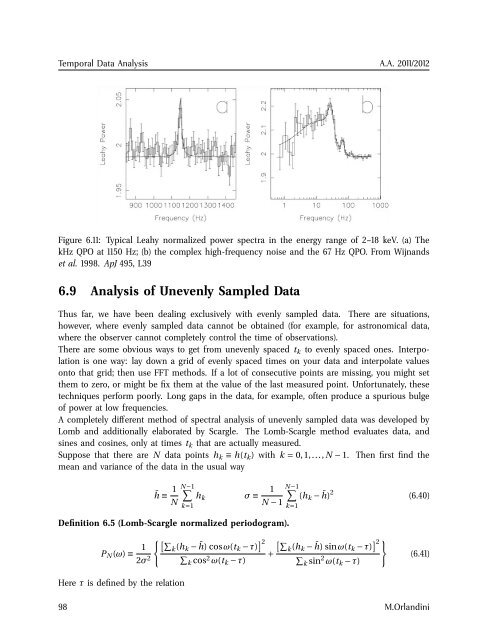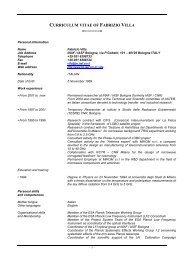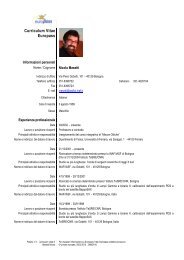booklet format - inaf iasf bologna
booklet format - inaf iasf bologna
booklet format - inaf iasf bologna
Create successful ePaper yourself
Turn your PDF publications into a flip-book with our unique Google optimized e-Paper software.
Temporal Data Analysis A.A. 2011/2012<br />
Figure 6.11: Typical Leahy normalized power spectra in the energy range of 2–18 keV. (a) The<br />
kHz QPO at 1150 Hz; (b) the complex high-frequency noise and the 67 Hz QPO. From Wijnands<br />
et al. 1998. ApJ 495, L39<br />
6.9 Analysis of Unevenly Sampled Data<br />
Thus far, we have been dealing exclusively with evenly sampled data. There are situations,<br />
however, where evenly sampled data cannot be obtained (for example, for astronomical data,<br />
where the observer cannot completely control the time of observations).<br />
There are some obvious ways to get from unevenly spaced t k to evenly spaced ones. Interpolation<br />
is one way: lay down a grid of evenly spaced times on your data and interpolate values<br />
onto that grid; then use FFT methods. If a lot of consecutive points are missing, you might set<br />
them to zero, or might be fix them at the value of the last measured point. Unfortunately, these<br />
techniques perform poorly. Long gaps in the data, for example, often produce a spurious bulge<br />
of power at low frequencies.<br />
A completely different method of spectral analysis of unevenly sampled data was developed by<br />
Lomb and additionally elaborated by Scargle. The Lomb-Scargle method evaluates data, and<br />
sines and cosines, only at times t k that are actually measured.<br />
Suppose that there are N data points h k ≡ h(t k ) with k = 0,1,..., N − 1. Then first find the<br />
mean and variance of the data in the usual way<br />
¯h ≡ 1 N<br />
N−1 ∑<br />
k=1<br />
h k σ ≡ 1 N−1 ∑<br />
N − 1<br />
k=1<br />
(h k − ¯h) 2 (6.40)<br />
Definition 6.5 (Lomb-Scargle normalized periodogram).<br />
{[∑<br />
P N (ω) ≡ 1 k(h k − ¯h) cosω(t k − τ) ] 2<br />
2σ 2 ∑<br />
k cos 2 +<br />
ω(t k − τ)<br />
[∑k(h k − ¯h) sinω(t k − τ) ] 2<br />
}<br />
∑<br />
k sin 2 ω(t k − τ)<br />
(6.41)<br />
Here τ is defined by the relation<br />
98 M.Orlandini

















